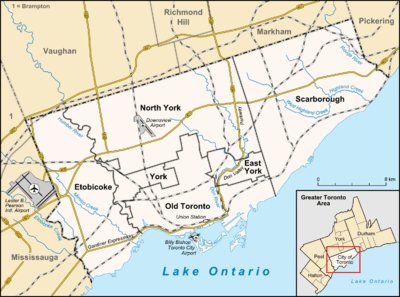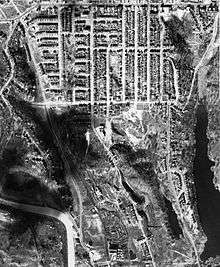Swansea, Toronto
| Swansea | |
|---|---|
| Neighbourhood | |
|
Former Swansea Town Hall | |
 Swansea neighbourhood map | |
 Location within Toronto | |
| Coordinates: 43°38′38″N 79°28′40″W / 43.64389°N 79.47778°WCoordinates: 43°38′38″N 79°28′40″W / 43.64389°N 79.47778°W | |
| Country |
|
| Province |
|
| City |
|
| Community | Toronto & East York |
| Established | 1889 (Subdivision) 'Windermere' |
| Incorporated | 1926 (Village) |
| Changed Municipality |
1954 1998 Toronto from Toronto (former) |
| Annexed | 1967 into Toronto (former) |
| Government | |
| • MP | Arif Virani (Parkdale—High Park) |
| • MPP | Cheri DiNovo (Parkdale—High Park) |
| • Councillor | Sarah Doucette (Ward 13 Parkdale—High Park) |
| Population (2006)[1] | |
| • Total | 11,133 |
| Source:Statistics Canada | |
Swansea is a neighbourhood in the City of Toronto, Ontario, Canada, bounded on the west by the Humber River, on the north by Bloor Street, on the east by High Park and on the south by Lake Ontario. The neighbourhood was originally a separate municipality, the Village of Swansea, which was annexed by the City of Toronto in 1967.
Character
Swansea is primarily residential in nature, consisting of a mix of various housing types. Swansea's high-end homes are located either at the western edge of High Park overlooking Grenadier Pond, or on Riverside Drive and the Brule Gardens enclave bordering the Humber river. Swansea also contains a large number of semi-detached houses and bungalows located mostly in the centre of the neighbourhood. The typical house of the area was built between 1905 and 1935.
The area of the former Swansea Works area is considerably newer, except for some of the original workers' homes. The Queensway was built in the 1950s through the Swansea Works lands. The area to the south was retained for industry and the area to the north was redeveloped with apartment buildings and townhome developments. The area of the actual factory site has been redeveloped since 2000 into townhomes and condominium apartments.
Swansea has several main streets. Along the northern boundary, Bloor Street is a four-lane arterial road with businesses lining both sides. Along the southern boundary, The Queensway is a four-lane arterial road with a streetcar right-of-way. The Queensway has primarily residences on both sides. North-south, Swansea has two major roads, South Kingsway and Windermere Avenue. Along the southern boundary is the Gardiner Expressway which has an interchange with South Kingsway and the CNR railway lines. Further to the south, Lake Shore Boulevard runs east-west parallel to the lake shore.
The area is extremely hilly in nature. The waters of Grenadier Pond, Rennie Pond and the Humber River all are at or near the level of Lake Ontario. The majority of the lands of 'upper' Swansea are 30 to 40 feet higher than this, with steep hillsides along Grenadier Pond, Humber River and Rennie Pond.
Culture
The former Swansea Town Hall is now the Swansea Town Hall Community Centre which includes a small gymnasium, and a selection of meeting rooms available for a variety of functions. It is also the home of the Swansea Memorial Public Library, the second smallest branch of the Toronto Public Library system. This branch specializes in material for children and seniors and provides complete inter-library loan services.
The annexation of Swansea into metropolitan Toronto was a contentious one, with many local residents opposed to the move. A common refrain before and during the annexation was that the area was (and still is) "not Toronto".
Demographics
Census tracts 0050.01 and 0050.02 of the 2006 Canadian census cover Swansea. According to that census, the neighborhood has 11,133 residents, up 0.5% since the 2001 census. Average income is $58,681, well above the Toronto average. Like much of West Toronto, the largest ethnic minorities are Eastern European. The ten most common languages in the neighbourhood, after English, are:
- Polish: 3.0%
- Ukrainian: 2.6%
- Serbian: 2.3%
- Russian: 2.2%
- French: 0.9%
- Portuguese: 0.9%
- Spanish: 0.8%
- Bengali: 0.7%
- Croatian: 0.7%
- Korean: 0.6%
Parks
Rennie Park, located on the east side of Rennie Terrace, south of Morningside Avenue, has four tennis courts, an artificial ice rink, and a wading pool. Swansea Recreational Centre, a part of Swansea Public School, has a gym and a swimming pool. High Park features a full day of recreational activities including fishing, theatre performances, train rides, an animal zoo, historical exhibits, a restaurant and a myriad of fitness opportunities.
History
Through the 19th century the area later known as Swansea was divided between two farm lots;
The western half of what is now Swansea was originally the home of Toronto's first European inhabitant, Jean Baptiste Rousseau, a French fur trader, who was permitted to occupy the site of a former French Fort at the foot of the Humber River[2] after the fall of the French Regime. Rousseau was living at his 'Rousseau House' when John Graves Simcoe arrived with Toronto's first settlers and Rousseau guided the new governor's ship into Toronto Bay (now Toronto's harbour).[3] When Toronto was first surveyed, however, the entire area along the Humber River was designated as a Mill Reserve (forest to be left intact for the use of the King's Sawmill, now called 'Old Mill'). Rousseau refused an offer to relocate across the river to Etobicoke and left the area. By the 1880s, the mill reserve in Swansea was still unused and the area was subdivided into 'wood lots' (sections of forest to be sold to families living further away for use as timber fuel). The site of 'Rousseau House' is today marked by a plaque.
The western half of Swansea became surveyed as lots 39 and 40. The lots were laid out south of Bloor Street, lot 1 starting to the east, and the numbers increasing in the western direction. Lot 40 was directly south-east of Jane Street extending east to where Windermere Avenue intersects Bloor Street. Lot 39, the next to the east saw the first development, on property owned by John Coe. By 1884, along Bloor Street, several blocks were subdivided as far south as today's Morningside Avenue, then known as Grenadier Road, and as far east as the today's Kennedy Avenue. These are the only streets in Swansea laid out on a grid pattern, possible because this section is relatively flat.
The eastern half of what is now Swansea was a forested lot purchased in 1838 by early Toronto artist, philanthropist and architect John Ellis whose home, 'Herne Hill', stood on Grenadier Heights overlooking Grenadier Pond.[4] The north-south street that connects to Grenadier Heights was named 'Ellis' in honour of Swansea's first family. Despite the building of a railway along the south of his estate in the 1850s, Mr Ellis did not develop his lot. With the death of John Ellis' widow in 1884, the Ellis estate became the property of John Ellis Jr. who sold off the land to the north of Herne Hill. The house itself was demolished in 1925. 71 acres (29 ha) of former Ellis lands on the east side of Grenadier Pond were bought by Toronto and merged with High Park in 1930.[4]

- Windermere & Swansea
By the 1880s, the area south of Bloor was known as 'Windermere' after England's 'Lake District' which it is said to have resembled.[5] To the south, industry developed on Coe's land along the railway line, including the Ontario Bolt Works, just east of the Humber, which replaced a factory on the site of today's streetcar yards at Roncesvalles. Built in 1882, its cornerstone laying attended by Sir John A. Macdonald,[6] the factory lands extended north to today's Morningside Avenue. In 1889, the factory was bought by James Worthington and the name changed to Swansea Works, Worthington himself being from the Swansea area of Wales. The factory became the major employer in the area with subsidiary industrial lands to the north of today's The Queensway. A settlement of workers' cottages built by Worthington dating from the 1880s grew around the plant.[5] The factory, burnt down in 1906 and rebuilt, became part of Stelco in 1910, and it remained in operation until 1989.
In the centre of Swansea were several elongated ponds running north-south. The largest, Catfish Pond, is the only one that has survived. Some of the ponds were filled in for the railway line and industrial area. One of the ponds on the former Coe property, on the site of today's Swansea Mews public housing project, was turned into a dump and filled in with tailings.[7]
By 1890, the area was known as Swansea, with a train stop on the Great Western at Windermere. The post office was in the Works building, and church services were also held there.[6] Worthington promoted the community, giving land for Swansea Public School in 1890 and the mission church.[5] Worthington's ownership of the Bolt Works ended not long afterward, and the Works was eventually absorbed into Stelco in 1910. Swansea, including Windermere, was incorporated as a village in 1926. The largely forested village saw the building of many upper-middle-class homes on the former Ellis estate as a quiet 'leafy' neighbourhood developed.
- Urbanisation

In 1954, the Village of Swansea left York County and joined the new region of Metropolitan Toronto. With the extension of Toronto's Queen Street and Queen streetcar line as 'The Queensway' along the southern limits of the village, Swansea quickly urbanised with many apartment buildings being built in the western half of the area. In 1967, Swansea became one of the two last independent villages (along with Forest Hill) to be annexed by the City of Toronto. Amalgamation resumed towards the end of the 20th Century as the other municipalities of Metropolitan Toronto formed the new 'Mega' City of Toronto in 1998. The small strip of industrial land between The Queensway and Lake Shore Boulevard has been largely redeveloped as a high-density residential mix of towers and townhouses.[8]
- Village Seal
The Swansea Village corporate seal reveals a great deal about the colourful history of this neighbourhood. Included on the Swansea seal is explorer Étienne Brûlé, who in 1615 became the first European to set foot on what is now Swansea and also shown is a First Nations member. This is symbolic in that it recognizes that First Nations members were the first people to inhabit Swansea, thousands of years ago. The hills in the Swansea Village seal represent Swansea's rolling countryside. The water in the Swansea seal refers to Swansea's natural boundaries, which include Lake Ontario, the Humber River and Grenadier Pond.
Prominent residents
- Lucy Maud Montgomery - writer of the Anne of Green Gables series of books, lived in a home at 210 Riverside Drive from 1935 to 1942. A small park named after Montgomery is located on Riverside Drive, between Riverside Trail and Riverside Crescent.[9]
References
- Lundell, Liz (1997). The estates of Old Toronto. Erin, Ontario: The Boston Mills Press. ISBN 1-55046-219-9.
- McLeod, Norman (1996). Walking Tour of Swansea. Toronto, Ontario: Swansea Historical Society. ISBN 0-9694593-2-7.
- ↑ 2006 Census (Statistics Canada tracts 5350050.001, 5350050.002)
- ↑ "Toronto Culture – Exploring Toronto's past – Natives and Newcomers, 1600-1793". City of Toronto. Retrieved 2009-10-28.
- ↑ http://www.webcitation.org/query?url=http://ca.geocities.com/mikebrown1%40rogers.com/Genealogy/bpbrown/Rousseaux_Window.html&date=2009-10-25+03:05:11
- 1 2 Lundell, pp. 116–117
- 1 2 3 "Swansea in Toronto". Planet Swansea. Retrieved 2009-10-27.
- 1 2 McLeod, p.26
- ↑ "History of the Area". Parkdale Community Legal Services. Retrieved 2009-10-27.
- ↑ http://www.world19.com/stelco_walkabout.htm
- ↑ http://www.torontoplaques.com/Pages/Lucy_Maud_Montgomery.html
External links
- History of Swansea Public School at Swansea Public School
- Swansea Toronto, Official Community Web Site
- High Park-Swansea neighborhood profile
 |
Runnymede-Bloor West Village | High Park North |  | |
| The Queensway-Humber Bay | |
High Park, Roncesvalles | ||
| ||||
| | ||||
| Mimico | Sunnyside |
